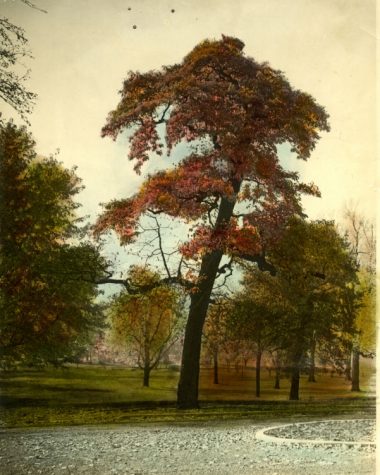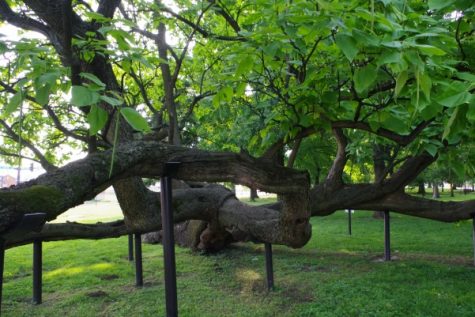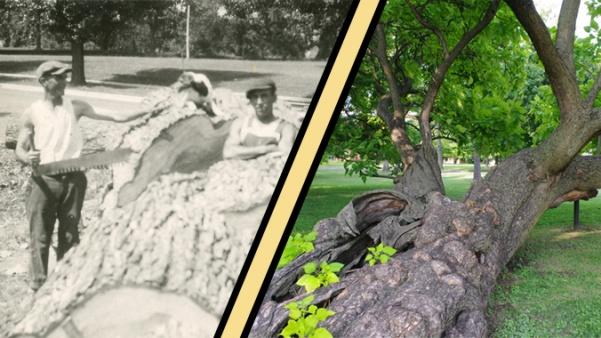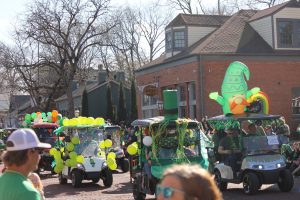Lindenwood Then and Now: rooted in history
Left: a linden tree known as “King of the Campus” after it was cut down in the 1920s.
Photo from the Mary E. Ambler Archives
Right: The historic catalpa tree near the edge of campus by the Alumnae Gate.
Photo by Kat Owens
September 11, 2018
MATT HAMPTON | Sports Editor
CORRECTION: A previous version of this story stated that former student Keith Askenasi was a men’s basketball coach. His name was also misspelled.
Lindenwood, a school itself named after a type of tree, has a campus filled with various verdant plants, but some of those plants are more famous than others.
The namesake
When Mary Easton Sibley established Linden Wood School for Girls in 1827, she named it after the linden trees which were abundantly found in the area.


Photo from the Mary E. Ambler Archives.
Over the years, one of Lindenwood’s namesake trees became known as “King of the Campus” because it was the tallest tree on campus and was believed to be at least as old as the college. University archivist Paul Huffman said in an email that “King of the Campus” was cut down in the 1920s because it died or was damaged in a storm.
But another tree on heritage campus also had a noteworthy history. In 1940, Missouri governor Lloyd C. Stark gave Lindenwood several lindens from his family business, Stark Bro’s Nurseries & Orchards Co.
Students referred to one of these trees as “Governor Stark.” Huffman said the location of this tree, or even if it is still standing, is unknown.
Not long after donating the lindens, Stark’s political career came to an end when he lost the Democratic primary for U.S. Senate to incumbent Harry S Truman. Afterwards, he went back to Stark Bro’s nursery, which is based in Pike County to this day. The now 202-year old company claims to have popularized golden and red delicious apples, from which “nearly 60% of the world’s apples are descended,” and according to its website, the first person to patent a variety of tree was Gov. Stark’s brother, Paul Stark Sr.
Groundskeeping director Kyle Routh said most lindens on campus are on heritage campus, but in recent years they have also been planted on the horizon side. Most lindens on new campus are a different species than the original American lindens, because European lindens have become more popular in nurseries.
Original school colors were yellow and white
Lindenwood designated the field daisy as its official flower in 1914 because it matched the original colors of the college: yellow and white.
According to Huffman, Lindenwood has used black and gold for a few decades, but it had no official school colors until it joined the NCAA in 2010.
Glen Cerny, who played basketball at Lindenwood in the 1970s, said in an oral history interview that student Keith Askenasi chose black and gold for the teams because “he liked the Pittsburgh Pirates’ colors.” Cerny said the women wore white and navy blue at the time.
Also known as the oxeye daisy, the field daisy is a perennial wildflower native to Europe and now found in all 50 states. Because of its hardiness, it can be an invasive species in some areas, according to the Center for Invasive Species and Ecosystem Health.
The crooked catalpa


Inside the fence on the edge of campus near the alumnae gate, there is a sprawling old tree held by supports. Huffman said little is known about the historic catalpa tree, also known as a cigar tree or Indian bean tree.
The catalpa is estimated to be 100-150 years old. Routh said its exact age cannot be determined because of rot, but the tree is “not as old as everyone thinks it is” and he thinks it is closer to 100 years old.
Routh said when he started working at Lindenwood 17 years ago, the tree did not lean as much as it does now, but it was quickly deteriorating, “losing an inch a month.” Routh asked President Dennis Spellmann for permission to build supports to keep the catalpa from collapsing, but Spellmann required that they be made from natural wood. These natural wood supports had to be replaced as they rotted over time, and part of the tree collapsed when one gave way.
After Spellmann’s death, Routh replaced the wooden supports with the metal ones that hold the tree today.
The historic catalpa is also supposedly the namesake of The Crooked Tree Coffee House a few blocks from campus on First Capitol Drive.
—
Since Lindenwood’s foundation as a girls’ college when Missouri had been a state for less than a decade, the school has had a rich and unique history. This is the first article of Lindenwood Then and Now, a series about the history of Lindenwood. Check back next week for more.










